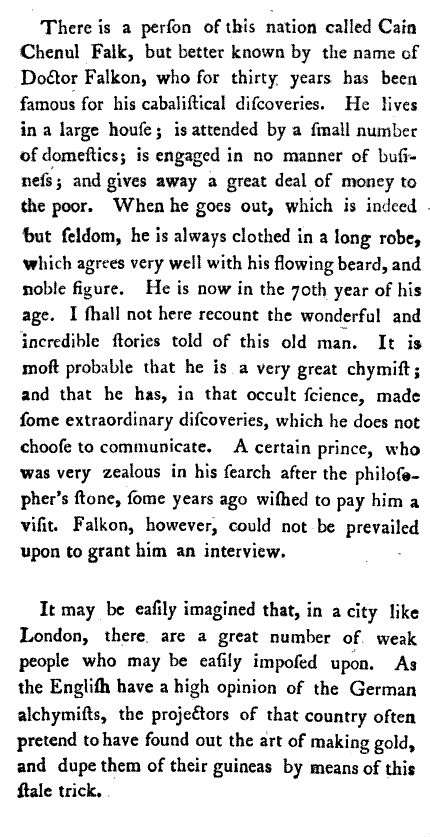As I posted here, his portrait is very often confused with that of the Ba'al Shem Tov.

Here is a very interesting anecdote concerning his portrait, from Irene Roth's loving biography and tribute to her husband, "Cecil Roth, Historian Without Tears." Irene was a descendant of this Ba'al Shem of London:



As you can see, the original painting hung in the Roth home! His wife, surnamed Collins, was actually descended from Hirsch Kalisch - the Ba'al Shem's secretary. (The name "Collins" was Anglicized from Kalisch.) According to Collins family lore, their ancestor's son married the Ba'al Shem's daughter. Thus, Irene Roth was not only a descendent of Hirsch Kalisch, but also his father-in-law, the Ba'al Shem himself!
It is well known that this Ba'al Shem (recently blogged about by Menachem) was a special target of R. Ya'akov Emden for his Sabbatean leanings. He is also mentioned in a very interesting excerpt from the Chida's travelog:

For those who don't understand Hebrew well, the upshot is that while traveling in France, the Chida (R. Hayyim Yosef David Azulai) was visited by a Marquis and a Marquise, who asked him to pray for her. She also told him that she is learned in Scripture and can conjure up angels. However, if the angels and apparitions are from the dark side, she spurns them! She donated a Louis coin for the cause of Hebron Jewry (which the Chida was collecting for). Then she mentioned the Ba'al Shem of London and that someone had given her a kabbalah book, and many things about the subject! ("Amazing!" is the Chida's reaction.) She also claimed to have saved many Jews of Avignon from the Inquisition, has noble lineage, etc. etc. All this nonsense that she and many non-Jews were speaking of is all due to this so-called Ba'al Shem, who in his arrogance is revealing 'practical' kabbalah and incantations to nobles, for his own aggrandizement. Many asked him about it, and he replied. (It would be nice to know what.)
"The next morning I went to the Bibliotheque..." (22 years previously the Chida had been the first Jew permitted to visit the Hebraica collection of a great European library, in this case, the Bibliotheque Nationale de France. Here he describes what he looked at in a new visit.)
In any case, in European society he was known as Dr. Falk, or Falkon. There is a well-known reference to him in a French-language study of contemporary England, here as "A picture of England," (1789, 2 vols.) translated by Johann Wilhelm von Archenholz:

Incidentally, the reason why he is called "Cain Chenul Falk," in this passage (his name was Chaim Shmuel) must be because for some reason there was an /m/ /n/ confusion, a common enough and explainable error. Perhaps the reason here is because the French author had only heard the name spoken. The /Ch/ in "Chenul," is simply the French for /sh/. Thus, the name is "Cain Shemul Falk," in English spelling.
Finally, here is a rather, uh, illuminating foray into Falk's subconscious from Michael Oron's paper on Falk:

*"Eltere-Zide" = Great-grandfather.

He was a Polish-born Sephardic Jew whose real family name was Laniado.
ReplyDelete